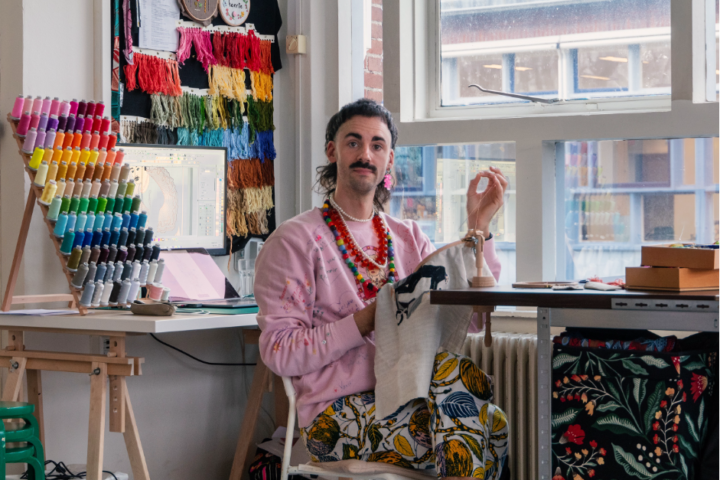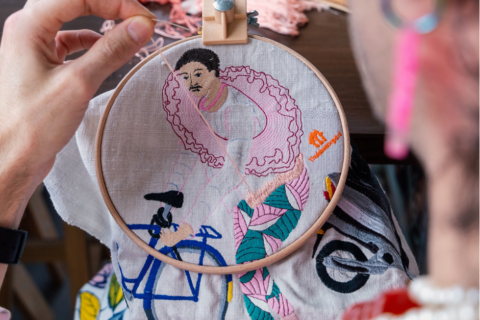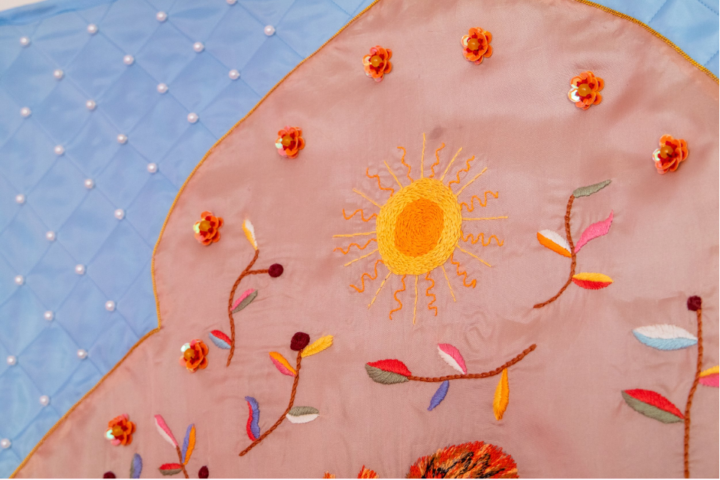Stitching journeys: Artist Theodorus Johannes reflects on the Living Heritage Journeys project development

Theodorus Johannes (they/them) is a Dutch textile artist, researcher, and storyteller whose work bridges documentary film and needlework. Deeply rooted in themes of identity, authenticity, and social engagement, their artistic practice explores textiles and fashion as powerful forms of communication—often drawing on community, folklore, and lived experience.
Theodoor has been invited by the Living Heritage Journeys team to observe, reflect on, and artistically interpret the project’s unfolding journey. In conversation with the team, they shared insights into their artistic background, creative process, and the vision for the embroidered artwork they will create as a response to the project.
From Fashion to Folklore: A Journey into Craft
Originally studying fashion, Theodoor did not set out to be an embroiderer, but became increasingly disillusioned with the modern fashion industry, and began to research the Dutch national costume history. Delving into folkloric histories, they developed a deep respect for craft across cultures and through the ages. Their fascination with embroidery developed through learning about its rich, symbolic language. “Every colour, every motif has a different meaning,” they explain. Referring to traditional textile pieces they have researched, “It can mean that you're looking for a husband. It can mean that your husband has just died.”
Their own embroidery draws on this tradition, but also adds personal layers of meaning. “I guess you could say it has a symbolism, but usually a symbolism of my own,” they reflect, noting how viewers often connect with these meanings through shared stories and emotional resonance.

The tactile quality of embroidery is central to their practice. “When I embroider, I want to feel the surface,” Theodoor says. “The yarn tickling my fingers… that really keeps me going.” They observe how people’s instinctive reaction to embroidery is often to touch it—something we lack in a world dominated by screens. “The surfaces we touch these days are keyboards and glass from our phones. Our fingers are hungry.”
This sense of touch informs how they plan to present their final artwork for Living Heritage Journeys—unframed and not behind glass, so its texture and physical presence remain intact.
Reflections on imagery, tourism, and living heritage
Reflecting more broadly on the themes of the Living Heritage Journeys project, Theodoor is deeply aware of the complex relationship between heritage and tourism. While tourists seek cultural encounters, their impact can sometimes be harmful or extractive. They wonder what people take away from these moments—and whether they truly see the communities behind the heritage.
They state how making pictures and images is an important part of tourism, and a means by which we keep memories but also “in a way to make sense of the world”. “So I’m hoping that by making an artwork like this, I can make sense of the world we're living in. And maybe, other people can too.”
Looking ahead, their ultimate wish for Living Heritage Journeys is that it encourages integrating intangible heritage into everyday life. That, Theodoor says, would be “a grander wish towards life in general”.
Observing Complexity, Honouring Craft
The scale and scope of Living Heritage Journeys presents both a challenge and an opportunity. “It’s such a huge scheme,” Theodoor admits. “There are all these little nooks and crannies... all these things that need to be taken into account. That complexity is also what makes it so interesting.”
Their previous work with organisations such as the Kenniscentrum Immaterieel Erfgoed (Dutch Centre for Intangible Heritage) and the Dutch Crafts Council has shaped their perspective. Through video and embroidery, they’ve explored the invaluable role of craftspeople in society, and how intangible heritage has had a profound impact on their own identity. “Craftsmanship has influenced my life,” they say simply.
What drew them to this project, they explain, was a fear of loss. “There’s such a loss of culture across the world when we do away with these crafts”, weakening the “glue” in communities. Theodoor feels their role is to bear witness to these traditions, amplify the voices of heritage communities, and advocate for their value.
Listening and Translating: The Artist as Observer

© Barbara Rigon, Associazione Giochi Antichi
Attending monthly online consortium meetings and the transnational gathering in Venice, Theodoor describes themselves as “a fly on the wall”. While following the more academic discourse, and contemplating various terms and ideas discussed, Theodoor stresses it is the voices of the heritage communities themselves that provide great inspiration. One powerful moment they recall from the Venice meeting was hearing a member of the Voga (standing rowing) community exclaim: “Innovation starts with tradition”. Theodoor describes it as “a scream for being understood”.
In their artistic process, Theodoor is collecting words, images, and impressions—“data,” in their words—that will be distilled into embroidery. Their vision includes integrating the lion of Saint Mark, a powerful Venetian symbol, alongside motifs representing the many voices and actors involved in the project.
Theodoor hopes during their research to visit some of the other pilot locations and to speak to the practitioners. They are eager, for instance, to visit the Szopka makers in Kraków, drawn to the miniature tools—scissors, tweezers—used to create the intricate nativity scenes. These, too, may become embroidered symbols of craftsmanship.
Crafting with Time and Care

Time is a defining element of Theodoor’s work. Even with machine assistance, embroidery is labour-intensive. “A simple piece can still take over 20 hours”, they note. To manage this, given the complexity of the piece they envision, they plan to machine-embroider certain components and then hand-assemble the final artwork—a new approach that may influence their broader practice.
Mindful that the project itself is a journey that they wish to follow and interpret in their artwork, they do not rush to begin stitching, rather take time to observe and reflect, allowing their work to be informed by the evolving process of Living Heritage Journeys.
Sketching plays a part in this development, including digital tools that allow for scaling, cropping, and editing designs. Key quotes, meetings, artworks, and encounters are gradually forming the patchwork of what will become their final piece.
Language and audience
Language—its use, its audience—is another area they have been reflecting upon. “Using very academic language does not serve everyone”, Theodoor observes. They are committed to creating a work that is inclusive and accessible.
When asked who they see as the audience for their embroidery, their first thought is for the heritage practitioners themselves. They also envision a broader public, inspired by a comment heard about the carillon in the Belgian pilot: that the sound of carillon bells is “for everyone”. Theodoor sees their art the same way—something shared, open, and universal.
They also reflect on how we experience art today. “Most people look at an artwork for seven seconds”, they say. “What does that say about how we look at things?” Their hope is that the time-intensive nature of embroidery—like living heritage—can help slow us down and invite deeper engagement.
We’re delighted to have Theodoor Johannes contributing their creative perspective to Living Heritage Journeys, and we eagerly anticipate the artwork that will emerge from their thoughtful and observant journey alongside the project.